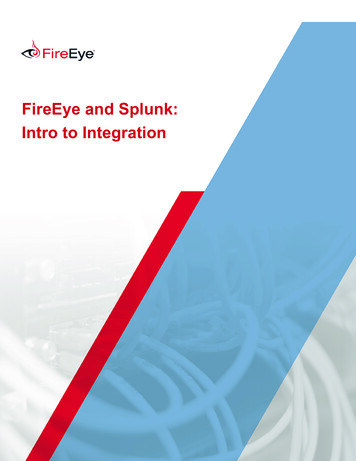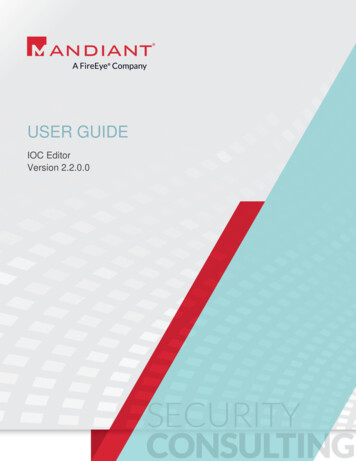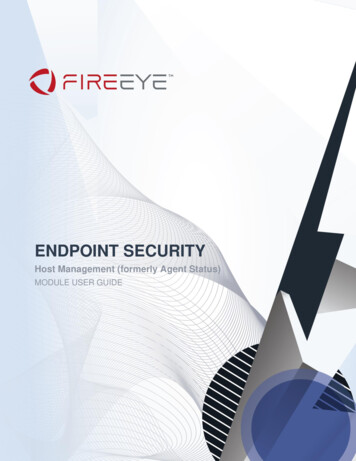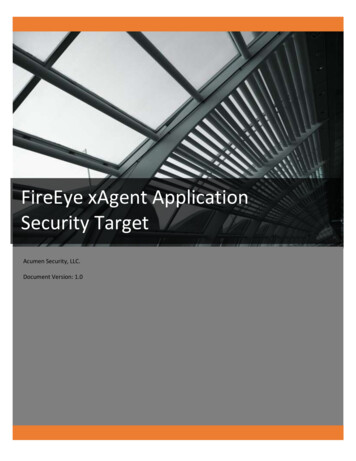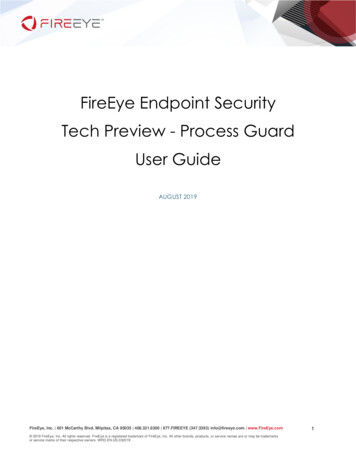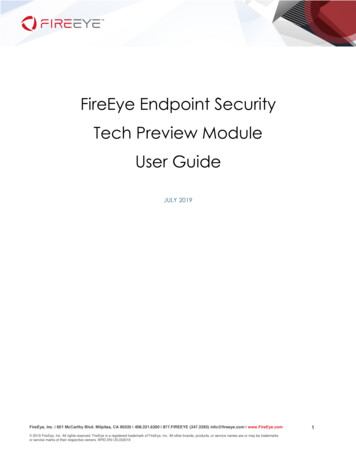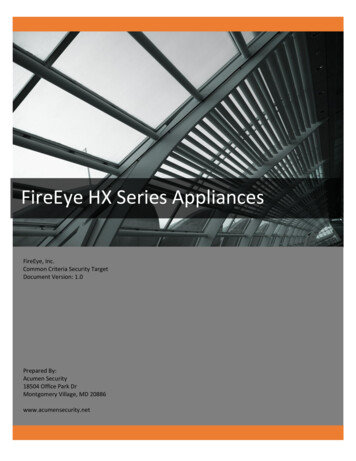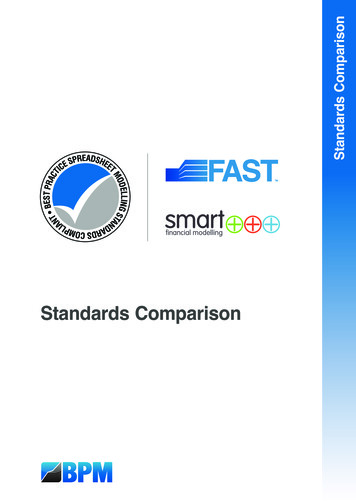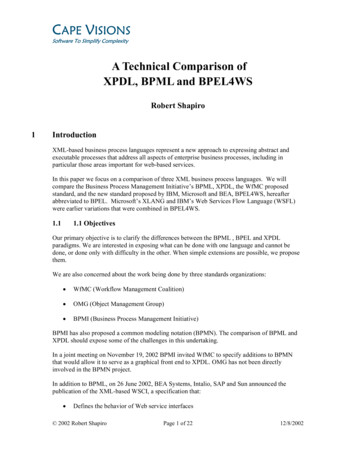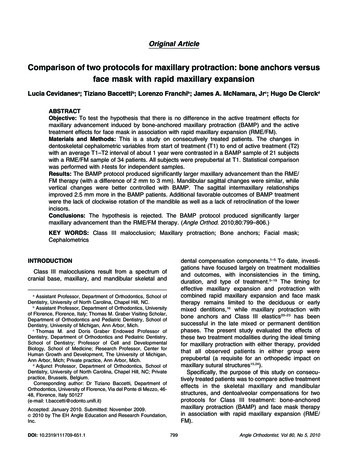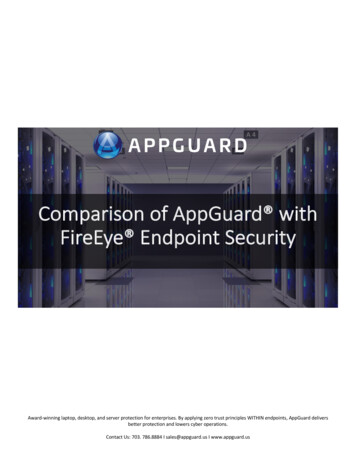
Transcription
Comparison of AppGuard withFireEye Endpoint SecurityAward-winning laptop, desktop, and server protection for enterprises. By applying zero trust principles WITHIN endpoints, AppGuard deliversbetter protection and lowers cyber operations.Contact Us: 703. 786.8884 I sales@appguard.us I www.appguard.us
AppGuardFireEyeEndpoint Preventative ProtectionExtensive, Real-time Malware BlockingLess Labor & Skills IntensiveOne-time App Patches for LifeProtects Mission Critical Apps from Rest of EndpointAppGuard is preventive endpoint protection;FireEye features numerous ‘detect & react’ toolsAside from detecting easily recognizable malware, FireEye is a predominately reactive tool against advancedor unknown attacks.AppGuard prevents malware compromises of laptops, desktops, and servers. With endpoint zero trust, itassumes legit computing processes can be harmful at any moment. Instead of detecting or reacting, itenforces controls that block and restrain harmful actions to prevent compromise. It uses app containment toblock harmful file and memory actions to other apps and the endpoint, as well as, app isolation to preventother endpoint processes from altering or stealing from an isolated app or resources. These and other zerotrust controls auto-adapt to app updates, patches, and the unknown, resulting in agents protecting hosts formonths to years from known and unknown malware without needing policy updates.AppGuard slashes demand for personnel and skills;FireEyes increases bothFireEye is similar to many other tools that monitor and investigate vast and diverse volumes of data frommultiple perspectives at multiple stages of malware attacks, before and after compromise. They are parsinginfinite possibilities, requiring more tools, more personnel, and more skills every year.The point of applying zero trust within the endpoint is to reap better protection for less effort. Rather thantrying to scale to parse more, AppGuard’s endpoint zero trust takes the opposite approach of drasticallyreducing what needs to be monitored and analyzed. It does this by avoiding the quagmire of telling good frombad and normal from abnormal amongst infinite possibilities.Customers praise AppGuard’s real-time protection effectiveness and its near set-and-forget operations. Itdefeats malware without having to detect it, resulting in better protection for less operations. Further, othercyber defense layers see substantially lower alert volumes because malware attacks are stopped at endpointsin real-time.Limited DistributionAppGuard, Inc. 2018
AppGuard is a zero-trust tool that needs no signatures;FireEye relies on manyFireEye relies on traditional antivirus signatures, machine learning binary analysis signatures, HIPS signatures(if HX involved), behavior analytics signatures, indicator of compromise (IOC), and many others to fueldefense. They also need currency, network exposure, network bandwidth, endpoint resources, andoperational effort. Worse, signature-based detections are limited to the familiar.AppGuard abhors signatures. It uses simple zero-trust methods to block actions rather than explicitlyrecognize malware. This is more effective and less burdensome.Major operational differences between AppGuard’s “block & restrain” vs.FireEye’s “guess & react”Traditional signatures identify an infinitesimally small percentage of malicious files. Machine learning (ML)strives to broaden that but is still limited to the familiar and is routinely defeated with obfuscation tactics.FireEye ML is making a statistical guess, which means there are false negatives and false positives. Because somuch still gets through due to the loopholes in this technique, FireEye’s ML strives to tell normal fromabnormal behavior after malware has detonated. This too is a statistical guess. FireEye’s EDR and networksensors hunt for anomalies, which when automated, is yet another statistical guess. Remember, ML is NOTartificial intelligence. ML does not comprehend or conceptualize; it only correlates without understanding.Human specialists are required to tune, investigate, remediate, restore, and report the consequences of thebad guesses. Worse, ML models degrade with change, which is the single greatest characteristic of enterprisecomputing. ML is reducing the growth in labor costs at best while increasing the requirements for skills. All thisequates to considerable “guess & react” direct labor costs for FireEye’s approach.AppGuard does not judge good from bad or normal from abnormal. It simply blocks unacceptable actions.Because AppGuard does not “guess”, it blocks or allows actions based on deterministic criteria. When noneexists, it restrains. For example, rather than “guess” whether a document is weaponized, or Microsoft Wordhas been hijacked, AppGuard restrains all processes resulting from Word’s operation from conductingunacceptable (deterministic) actions. AppGuard’s App containment and isolation creates crisscrossing micro,adaptive compartments that defeat endpoint attacks by blocking or restraining the actions the adversary mustcomplete within an endpoint to achieve the adversary’s goals.AppGuard agents are undiminished from months of isolation;FireEye’s requires continuous feedsAn enterprise’s analysts operating FireEye require vast amounts of data in many forms from the endpointagents to ‘react’ to what’s already happened. Any isolation, whether temporary or prolonged, diminishesFireEye’s capabilities. AppGuard’s remain fully effective.Limited DistributionAppGuard, Inc. 2018
Pass-the-Hash/Ticket Attacks: AppGuard Blocks them in Real-time;FireEye might Detect them, EventuallyAdversaries read the memory of the OS process that caches end-user credentials, so end-users don’t have totype their user name and password each time they access something different. If such a credential is of highprivileges, the adversary can use it to logon to other endpoints, systematically seeking credentials of greaterprivileges to access more restricted endpoints. AppGuard’s app containment ensures Apps cannot read/stealcredential from the OS’s memory. Isolation of the OS process and other credential stores prevents even anunknown, malicious process from stealing credentials.FireEye’s behavior analytics aspires to detect & react to such attacks. If HIPS feature from HX are included,they may or may not succeed because such controls are relatively static, leaving opportunities for adversariesto bypass them.Remote Code Execution Attacks from ‘Trusted’ Endpoints:AppGuard Blocks & FireEye DetectsAppGuard’s zero trust controls block attacks attempting to use any OS and 3rd party infrastructure tools(PsExec, Remote PowerShell, SSH, etc.) tools. It allows IT/Sec-Ops personnel to use them on-demand. Andbecause AppGuard’s controls are contextual, simultaneous adversary attacks are still blocked.Many endpoint protection tools tend to be on/off, leaving a window of vulnerability for attackers while IT/SecOps is using infrastructure tools. FireEye’s methods for mitigating such risks are unclear. We believe they relyon behavior analytics and EDR to detect malice and then react after execution.In-Memory Attacks: AppGuard Blocks Them;FireEye mostly Relies on Post-Detonation DetectionAppGuard’s App containment and isolation control blocks code injections. Avoiding any guesswork, AppGuardblocks all harmful actions from malicious code. FireEye relies on behavior analytics and EDR to detect maliceand then react after execution.Malicious Files: AppGuard’s Mitigation is Simpler and more Effective than FireEye’sAV is notoriously ineffective. Machine learning AV aspires to do better but is routinely defeated withobfuscation and polymorphism tactics. On top of this, FireEye adds EDR and behavior analytics to identifywhat they fail to detect. This amounts to four major tools in one agent. That means complexity, waste, andhigher IT/Sec-Ops costs.Limited DistributionAppGuard, Inc. 2018
AppGuard’s zero trust approach is simpler. Untrustworthy files are not allowed to launch. Those allowed tolaunch (e.g., validated digital signature & file integrity), are contained. Unlike whitelisting or HIPS, customerssay AppGuard is close to ‘set & forget’.AppGuard acts like a one-time, universal patch;FireEye is less effective when patches are missingAppGuard was named for its mistrust of applications and utilities. Ultimately, malware attacks use them to doharm by exploiting a missing patch, using a zero-day exploit, SQL injection, and more. AppGuard assumes thatany process from an App might do bad things at any moment, dynamically containing each to block harm. Thiscontainment naturally adapts to App changes and any unanticipated behavior. An unpatched App is hardlydifferent to a patched one. Defining a rule to contain an App is as easy as adding a song to a playlist. IT-Opspersonnel can implement App patches when convenient.FireEye and those operating it must work harder in the absence of patches. IT-Ops must test and implementpatches ASAP.AppGuard Isolation Allows Mission Critical Apps to Safely Run despite Malice in Rest of Server;FireEye cannotIf a workstation is compromised, usually only one person is disrupted. But a server disruption can impact anentire enterprise. AppGuard isolation protects mission critical Apps from the rest of the endpoint withouthaving to know all about the other processes on it. IT-Ops then has options available to it that other endpointprotection agents do not offer, the mission critical App can continue to run safely until the next maintenancewindow. Other tools like FireEye quarantine, terminate, and/or restore the server, disrupting the missioncritical App.AppGuard will not impact endpoint performance;FireEye needs 10 to 200 times more resourcesThe FireEye endpoint footprint is not published, other than that it also requires 300 MB of free disk space.AppGuard’s install size is about 30 MB. Its CPU usage is 0.0% at system idle and seldom exceeds 0.1% atsystem active. Its memory use is only 10 MB. Given FireEye’s similarity to many other endpoint agents, weexpect its steady-state footprint is 10 to 200 times higher. File scanning and analysis, which AppGuard doesnot do, can also temporarily impact performance even more.AppGuard is ideal for VDI endpoint protection;FireEye customers cite virtual environments as a gapCustomers have said FireEye does not work well in virtual environments but offered no specifics. We believethey are referring to performance impact. The number of VDI sessions a server can host depends on endpointfootprint. VDI servers can host more sessions with AppGuard because its footprint is extremely low.Limited DistributionAppGuard, Inc. 2018
AppGuard introduces no privacy or data loss risks by uploading files elsewhere for analysis;FireEye doesTo better deal with the unfamiliar, FireEye offers options for the agent to upload suspicious files for analysis byother tools. Users should consider potential data loss risks. There have been multiple reports of uploadeddocuments leaving the enterprise. While uploading files to be analyzed improves detection, “context aware”malware is designed to elude this. And yet other malware, simply starts and remains dormant to wait-out asandbox.AppGuard does not and has no need to upload files. It either prevents untrustworthy files from launchingand/or ensures they can do no harmful actions.AppGuard has no pre-requisite support demands;FireEye endpoint applications REQUIRE numerous FireEye applicationsFireEye’s endpoint protection for XP is limited to AV and EDR. AppGuard’s protection remains effective, evenon XP.FireEye endpoint agents REQUIRE numerous FireEye appliances; AppGuard has no such pre-requisitesFireEye customer reports state that they must login to individual appliances to view all agent data. There is nocentralized appliance to manage all agents. FireEye HXD appliances act as intermedium between agents andHX controller. We are more confused by the inter-dependencies than their customers. Evidently, one mustlicense multiple appliances to deploy the endpoint agents.AppGuard Enterprise agents are centrally managed. There are self-managed agents for different use-cases.Product customers need only license the agents and the management application from AppGuard, nothingelse.Summary: AppGuard’s zero trust is like no other vendor’s endpoint protectionAppGuard is simpler and requires far less effort to deploy, maintain, and operateFireEye provides IT/Sec-Ops personnel with vast amounts of data to defend the enterpriseFireEye increases demand for more personnel, higher skills throughout a cyber program; AppGuardfrees them to do other workContact Us: 703. 786.8884 I sales@appguard.us I www.appguard.usLimited DistributionAppGuard, Inc. 2018
FireEye endpoint agents REQUIRE numerous FireEye appliances; AppGuard has no such pre-requisites FireEye customer reports state that they must login to individual appliances to view all agent data. There is no centralized appliance to manage all agents. FireEye HXD appliances act as inte
